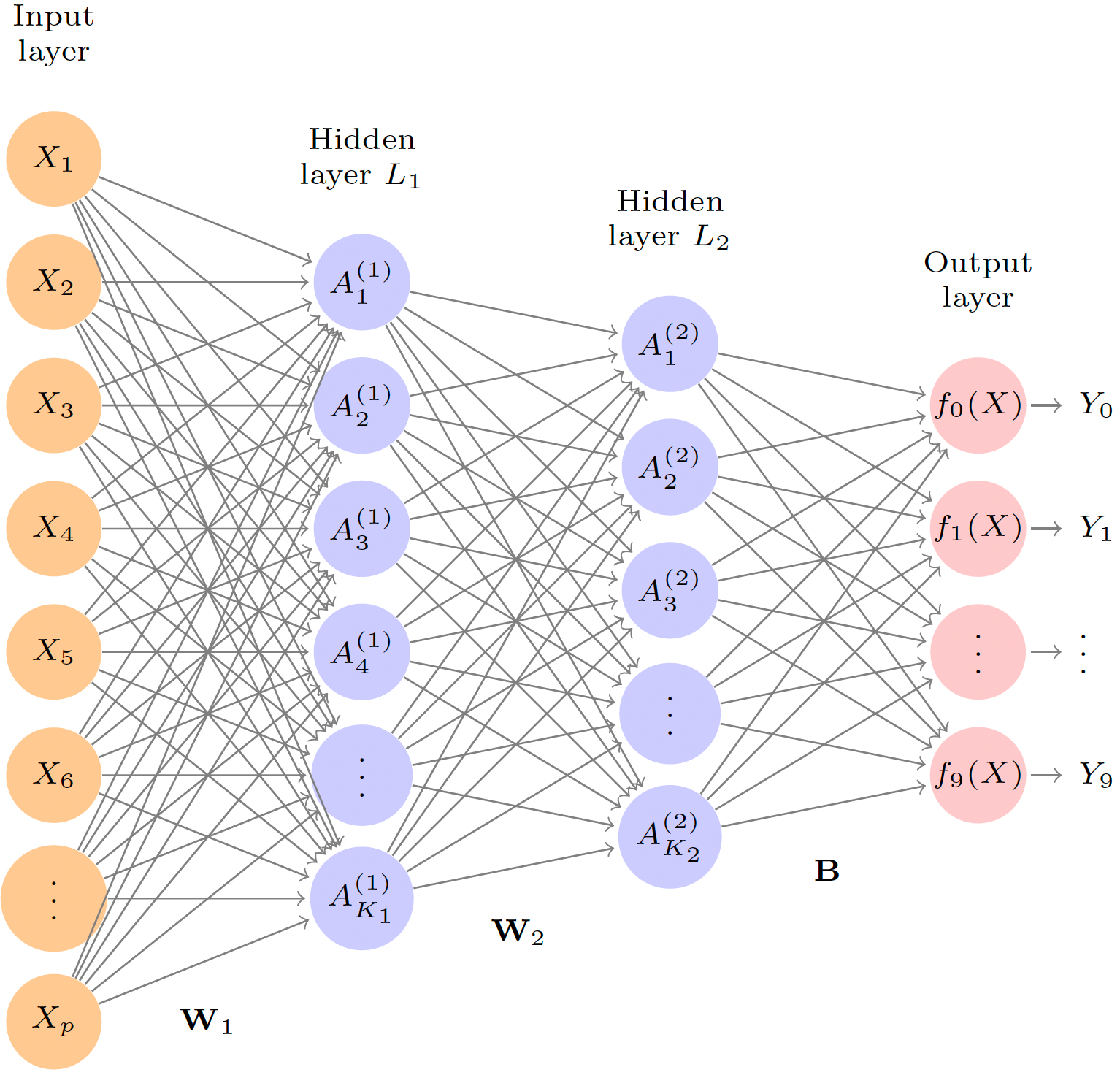
Artificial Neural Networks 🙌
MSSC 6250 Statistical Machine Learning
Department of Mathematical and Statistical Sciences
Marquette University
Feed-forward Neural Networks
Neural Networks
- An (artifical) neural network is a machine learning model inspired by the biological neural networks that constitute animal brains.

Deep Learning
A neural network takes an input vector of \(p\) variables \(X = (X_1, X_2, \dots, X_p)\) and builds a nonlinear function \(f(X)\) to predict the response \(Y\).
A neural network with several hidden layers is called a deep neural network, or deep learning.

Source: ISL Ch 10

Source: http://brainstormingbox.org/a-beginners-guide-to-neural-networks/
Single (Hidden) Layer Neural Network with One Output
Starts from inputs \(X\), for each hidden neuron \(A_k\), \(k = 1, \dots, K\),
\(A_k(X) = g(w_{k0} + w_{k1}X_1 + \cdots + w_{kp}X_p)\)
\(f(X) = g_f(\beta_0 + \beta_1A_1(X) + \cdots + \beta_KA_K(X))\)
\(g_k(z)\) and \(g_f(z)\) are (non)linear activation functions that are specified in advance.
\(\beta_0, \dots, \beta_K\) and \(w_{10}, \dots, w_{1p}, \dots, w_{K0}, \dots, w_{Kp}\) are parameters to be estimated.
- \(p = 4, K = 5\)
Linear Regression as Neural Network
Can we represent a linear regression model as a neural network?
-
YES! Linear regression is a single layer neural network with
- identity activation \(g(z) = z\) and \(g_f(z) = z\)
- \(p = K\)
- \(w_{kk} = 1\) and \(w_{kj} = 0\) for all \(k \ne j\)
Logistic Regression as Neural Network
Can we represent a binary logistic regression model as a neural network?
-
YES! Binary logistic regression is a single layer neural network with
- identity activation \(g(z) = z\)
- sigmoid activation \(g_f(z) = \frac{e^{z}}{1+e^z}\)
- \(p = K\)
- \(w_{kk} = 1\) and \(w_{kj} = 0\) for all \(k \ne j\)
Activation Functions
Activation functions are usually continuous for optimization purpose.
- sigmoid: \(\frac{1}{1+e^{-z}} = \frac{e^z}{1+e^z}\)
- hyperbolic tangent: \(\frac{e^z - e^{-z}}{e^z + e^{-z}}\)
- rectified linear unit (ReLU): \(\max(0, z)\); \(\ln(1 + e^z)\) (Soft version)
- Gaussian-error linear unit (GELU): \(z \Phi(z)\), where \(\Phi(\cdot)\) is the \(N(0, 1)\) CDF

Choose a Activation Function
-
The activation function used in hidden layers is typically chosen based on the type of neural network architecture.
- Multilayer Perceptron (MLP): ReLU (leaky ReLU)
- Convolutional Neural Network: ReLU
- Recurrent Neural Network: Tanh and/or Sigmoid
never use softmax and identity functions in the hidden layers.
-
For output activation function,
- Regression: One node, Linear
- Binary Classification: One node, Sigmoid
- Multiclass Classification: One node per class, Softmax
- Multilabel Classification: One node per class, Sigmoid
When to Use Deep Learning
The signal to noise ratio is high.
The sample size is huge.
Interpretability of the model is not a priority.
When possible, try the simpler models as well, and then make a choice based on the performance/complexity tradeoff.
Occam’s razor principle: when faced with several methods that give roughly equivalent performance, pick the simplest.
Fitting Neural Networks

\[\min_{\boldsymbol \beta, \{\mathbf{w}\}_1^K} \frac{1}{2}\sum_{i=1}^n\left(y_i - f(x_i) \right)^2,\] where \[f(x_i) = \beta_0 + \sum_{k=1}^K\beta_Kg\left( w_{k0} + \sum_{j=1}^pw_{kj}x_{xj}\right).\]
- This problem is difficult because the objective is non-convex: there are multiple solutions.
Gradient Descent
For the objective function \(R(\theta)\) and the parameter vector \(\theta\) to be estimated, gradient descent keeps finding new parameter value that reduces the objective until the objective fails to decrease.
\(\theta^{(t+1)} = \theta^{(t)} -\rho\nabla R(\theta^{(t)})\), where \(\rho\) is the learning rate that is typically small like 0.001.
\(\nabla R(\theta^{(t)}) = \left. \frac{\partial R(\theta)}{\partial \theta} \right \rvert_{\theta = \theta^{(t)}}\)
Backpropagation
\[\begin{align} R(\theta) \overset{\triangle}{=} \sum_{i=1}^nR_i(\theta) =& \frac{1}{2}\sum_{i=1}^n \big(y_i - f_{\theta}(x_i)\big)^2\\ =& \frac{1}{2} \sum_{i=1}^n \big(y_i - \beta_0 - \beta_1 g(w_1' x_i) - \cdots - \beta_K g(w_K' x_i) \big)^2 \\ \end{align}\]
- Nothing but chain rule for differentiation:
With \(z_{ik} = w_k' x_i\),
\[\frac{\partial R_i(\theta)}{\partial \beta_{k}} = \frac{\partial R_i(\theta)}{\partial f_{\theta}(x_i)} \cdot \frac{\partial f_{\theta}(x_i)}{\partial \beta_{k}} = {\color{red}{-\big( y_i - f_{\theta}(x_i)\big)}} \cdot g(z_{ik})\]
\[\frac{\partial R_i(\theta)}{w_{kj}} = \frac{\partial R_i(\theta)}{\partial f_{\theta}(x_i)} \cdot \frac{\partial f_{\theta}(x_i)}{\partial g(z_{ik})} \cdot \frac{\partial g(z_{ik})}{\partial z_{ik}} \cdot \frac{\partial z_{ik}}{\partial w_{kj}} = {\color{red}{-\big( y_i - f_{\theta}(x_i)\big)}} \cdot \beta_k \cdot g'(z_{ik}) \cdot x_{ij}\]
- Reuse the red part in different layers of gradients to reduce computational burden.
Other Topics
Stochastic Gradient Descent
Dropout Learning
Convolutional Neural Network (Spatial modeling)
Recurrent Neural Network (Temporal modeling)
Bayesian Deep Learning